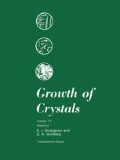Abstract
Lithium niobate is a colorless transparent crystal belonging to the trigonal system [1]. Congruent LiNbO3 crystals are grown from the melt by the Czochralski method. The composition of the most perfect of these, most frequently used in technology, is not stoichiometric relative to the molar concentrations of lithium and niobium. A lithium deficit in the amount of ~1.4 mole % occurs in them [2]. The chemical formula of the crystals is more accurately written as Li0.945NbO3 (deviation of the composition from stoichiometric in oxygen is unknown and is taken as zero). This peculiarity, as well as the dependence of the width of the region of homogeneity for the solid solutions based on lithium niobate as a function of temperature (Fig. 1), leads to identification of a second monoclinic phase LiNb3O8 upon cooling grown crystals below the limit of the monophasic region or during their heat treatment [3, 4]. Decomposition of supersaturated solid solutions is studied in detail for metallic alloys [5, 6] and much less for crystals of complicated compounds.
Access this chapter
Tax calculation will be finalised at checkout
Purchases are for personal use only
Preview
Unable to display preview. Download preview PDF.
Literature Cited
Yu. S. Kuz’minov, Lithium Niobate and Tantalate. Materials for Nonlinear Optics [in Russian], Nauka, Moscow (1975).
J. R. Carruthers, G. E. Peterson, M. Grasso, and P. M. Bridenbaugh, “Nonstoichiometry and crystal growth of lithium niobate,” J. Appl Phys., 42, No. 5, 1846–1851 (1971).
L. O. Svaasand, M. Eriksrud, G. Nakken, and A. P. Grande, “Solid-solution range of LiNb03,”J. CrysL Growth, 22, No. 3, 230–232 (1974).
M. N. Armenise, C. Canali, M. de Sario, et al., “Characterization of TiO2 LiNb3O8, and (Ti0.65Nb0.35)O2 compound growth observed during Ti:LiNbO3 optical waveguide fabrication,” J. AppL Phys., 54, No. 11, 6223–6231 (1983).
Ya. S. Umanskii, B. N. Finkel’shtein, and M. E. Blanter, Physical Principles of Metal Science [in Russian], Metallurgizdat, Moscow (1949).
B. Ya. Lyubov, Theory of Crystallization in Large Volumes [in Russian], Nauka, Moscow (1975).
Z. G. Pinsker, Electron Diffraction [in Russian], Izd. Akad. Nauk SSSR, Moscow (1949).
V. A. Yakovlev, “Ellipsometric monitoring of the surface state of anisotropic crystals,” in: Optics of Anisotropic Media [in Russian], Mosk. Fiz. Tekh. Inst., Moscow (1985), pp. 27–28.
G. M. Zverev, S. A. Kolyadin, E. A. Levchuk, and L. A. Skvortsov, “Effect of the surface layer on the resistance of lithium niobate to laser radiation,” Kvantovaya Élektron. (Moscow), 4, No. 9, 1882–1889 (1977).
B. K. Vainshtein, Structural Electron Diffraction [in Russian], Izd. Akad. Nauk SSSR, Moscow (1956).
M. Lundberg, “The crystal structure of LiNb3O8,” Acta Chem Scand, 25, No. 9, 3337–3346 (1971).
A. A. Chernov, E. I. Givargizov, Kh. S. Bagdasarov, et aL, Modern Crystallography: Crystal Formation, Vol. 3 [in Russian], Nauka, Moscow (1982).
S. C. Abrahams, J. M. Reddy, and J. L. Bernstein, “Ferroelectric lithium niobate. 3. Single crystal x-ray diffraction study at 24°C,” J. Phys. Chem Solids, 27, No. 6/7, 997–1012 (1966).
L. S. Palatnik and I. I. Papirov, Epitaxial Films [in Russian], Nauka, Moscow (1971).
G. V. Chaplygin, “Mutual orientation during heteroepitaxy,” in: Abstracts of Papers of the Vlth IntL Conf. on Crystal Growth, VoL 1 [in Russian], Inst. Kristallogr. Akad. Nauk SSSR, Moscow (1980), pp. 135–136.
A. V. Kuznetsov, S. A. Semiletov, and G. V. Chaplygin, “Orientation of gallium nitride on sapphire,” in: Growth of Crystals, Vol. 15, A. A. Chernov, ed., Consultants Bureau, New York (1988), pp. 14–24.
Editor information
Editors and Affiliations
Rights and permissions
Copyright information
© 1991 Consultants Bureau, New York
About this chapter
Cite this chapter
Semiletov, S.A., Bocharova, N.G., Rakova, E.V. (1991). Decomposition of a Solid Solution on the Surface of Lithium Niobate Crystals: Structure, Morphology, and Mutual Orientation of Phases. In: Givargizov, E.I., Grinberg, S.A. (eds) Growth of Crystals. Growth of Crystals, vol 17. Springer, Boston, MA. https://doi.org/10.1007/978-1-4615-3660-4_9
Download citation
DOI: https://doi.org/10.1007/978-1-4615-3660-4_9
Publisher Name: Springer, Boston, MA
Print ISBN: 978-1-4613-6629-4
Online ISBN: 978-1-4615-3660-4
eBook Packages: Springer Book Archive

